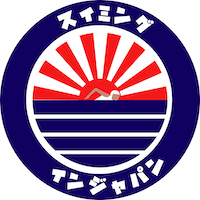While Japan is awash with great swim spots to suit all tastes, often even the most well-paddled places are not simple to get to, especially for short-stay tourists, those with minimal Japanese, or simply people with busy lives and little time to work it all out.
Let’s take a look in a little more detail at the options out there.
By car
Those from heavily car-dependent places like the USA and the Middle East will perhaps be surprised that in the two major megapolises (in the Kanto and Kansai regions) car ownership is comparatively low. Of course this changes in the more remote areas where the population and amenities are more scarce.
The upside of this is that car rental is very common, reasonable and an easy process to navigate. You are never far from a branch of
Nippon Rent-a-Car, which has an English-language website. Expect to pay 5000 JPY (for a very small car) for 24 hours and up. With a group, it’s an effective way to get out to some of the more far-flung wild spots and beaches. Do bear in mind that you will need either a valid Japanese Driver’s License (運転免許, Unten Menkyo) or an international license.
Not everyone has one of those, though. And sure, it might seem like you’re up against it when you want to get to the really remote places with no car, but, where there’s a will there’s a way and with a bit of research and ambition, all places should be reachable somehow.
Pros: The freedom of the open road is all yours with no timetables to watch for.
Cons: Roads can be busy and driving can be confusing for non-Japanese speakers.
By High Speed Train
For many, the train is the ultimate way to travel in Japan, typified by the image of the Bullet Train: fast, clean and comfortable, the Shinkansen (新幹線) will get you from A to B in many cases more efficiently than flying. For travel between major cities and destinations on the main islands the fast connections this jet-like carrier gives is ideal.
Being an island nation brings some limitations, for example hitting the famous beaches of Okinawa is impossible by bullet. The number of high-speed routes is still increasing though, and those not covered by the Shinkansen may have something similar, like the Odakyu Romance Car, or the numerous limited express trains.
Inside these trains there’s legroom, tables, a trolley service with very edible foods and a range of drinks options.
Unlike the suspicion rail companies seem to treat travellers with in some other countries, missing your train is not a problem as often there is non-reserved seating available. Simply trade your ticket in for the next departure time.
Travelling like this is at the pricier end of the scale, but visitors to Japan can save money by purchasing a JR rail pass which gives a lot of freedom to travel for 7 days. Not all the fastest trains, nor non-JR networks are covered, though so watch out. Recently there have been other passes too for specific regions, for example
these in the north and east regions.
Pros: It’s fast and smooth and takes you from A to B without the airport hassle and the footprint.
Cons: Though glamorous this can be one of the more expensive ways to get to the beaches and rivers.
By Local Train
Some places are not served by high-speed rail, but it is still possible to reach them by the slower local trains. Travelling at this pace, it’s possible to get a real taste of authentic rural and 郊外の
(suburban) life. The costs are much cheaper than the bullet trains but there are some stark differences in the experience, too.
Eating on local trains is usually frowned on, and seating is more than often sideways like in the city subway. On the upside, you’ll be delivered to some beautiful, showa-era stations in charming, clattering, empty cars.
It is possible to get special passes for the local JR trains, which are open to residents and visitors alike. These are available only seasonally, but allow you a wonderful sense of freedom to explore those hard to reach places. Check out the
JR website for more details.
Pros: Slow and steady, you can enjoy a different side to the country than most people get to see zooming between the hotspots.
Cons: The pace can be agonisingly slow and in the sticks, trains are infrequent - plan itineraries in advance to avoid wasting considerable amounts of time or you’ll get hot and bothered with long distances between swims.
By Bus
Perhaps most famous for its trains, but Japan has a highly efficient and comprehensive bus and coach network, with reasonable prices to boot. Shorter urban travel can be slow and inefficient but for longer distances, if you can bear the lack of leg space you won’t find a cheaper option.
The great thing about taking the coach is that the timings can work more in your favour. Whereas the first trains don’t start until dawn, the bus allows you to beat the train, and arrive at your destination in time fresh and early for a sunrise swim and a day’s activity. Well, maybe not so fresh, but early and maybe even better slept than you would be getting up at 4am for the first train.
Unlike the long-distance coach travel you may have experienced in the past, in Japan there is no danger of sleepless nights or noise as almost everybody seems to don a mask and pass out, even before departure. On the downside this does mean it’s hard to party on the bus, but every dark cloud … you do get to check out lots of very hi-tech coffee machines at service stations.
Check out Japan Bus Lines to search routes and availability.
Pros: It’s hard to beat the cost, and some destinations are not served by the express trains.
Cons: Space can be tight, and the multiple, regular pit stops at service stations can be tedious for some.
By Air Travel
It’s not the greenest option but some places are easier to fly to. Okinawa’s main town of Naha can by reached in a matter of a few hours from Tokyo this way, although from there you might want to travel onwards by boat to get to the best beaches in the area. Jetstar is the best on a budget, with other airlines up to ten times more expensive.
With the new Shinkansen connection to Hokkaido we would discourage the plane there if at all possible. You will see a whole different side to Japan cruising through the beautiful and underrated Tohoku region.
The great beaches of some of the Izu Shichito (7 Islands) can be reached via a cute plane leaving Chofu Airport in West Tokyo. This is a reasonably priced option and allows you to pretend you are Indiana Jones for an hour. The airline is called Central Air, details here. Further action fantasies of a more vintage James Bond flavour can be devoured by getting to the dramatic volcanic beach crater Aogashima (青ヶ島) in a small helicopter from neighbouring Hachiojima. Again, it’s surprisingly reasonable, check out the website for more information.
Pros: Air travel can be the simplest and most time efficient for those remote places not served by any other means. Plus it can allow you to have a once-in-a-lifetime helicopter trip
Cons: Definitely not the most environmentally friendly option when it is also possible to take boats and trains.
By Boat
An island nation, or a nation of islands? Geography alone means travel on high-speed boats and slower ferries is a practical and fun way to get places in Japan. By ferry, you can reach all manner of different spots. Small journeys vary: from seaside day trips to Sarushima (猿島) in Kanagawa, and to the countless little fishing islands in the south of Honshu Island, with longer journeys taking you to the beach paradise archipelagos of Okinawa and south of Kyushu, to the remote Tokyo Islands and natural wonder Sado (佐渡島) in Niigata. If you want to get to the beautiful, far flung Ogasawara Islands, you need to take a weekly 24-hour ferry from Tokyo.
It’s possible on ferries to make various intercity connections to ports within the main islands too, some of which take days. There are a range of accommodation types, with cheaper tatami mat beds and first class cabins.
As with rail travel there is a reasonably-priced unlimited pass available to tourists for inter-Japan boat travel.
Route details and booking here.
Pros: A greener option than flying, taking a boat allows a bit more time to enjoy the oceanic scenery.
Cons: It is a little frustrating spending so long on a boat and not being able to jump in!
Note
As a swimming website we can’t claim to be authorities on all travel options for getting to the beaches, rivers, lakes and waterfalls. Things change regularly so keep on eye on the official websites for all modes of transport. If you’re going far or remote, be prepared for it to take time, but remember, even if you’re in the middle of Tokyo you’re never far from somewhere beautiful to swim, and reasonable to get to.













